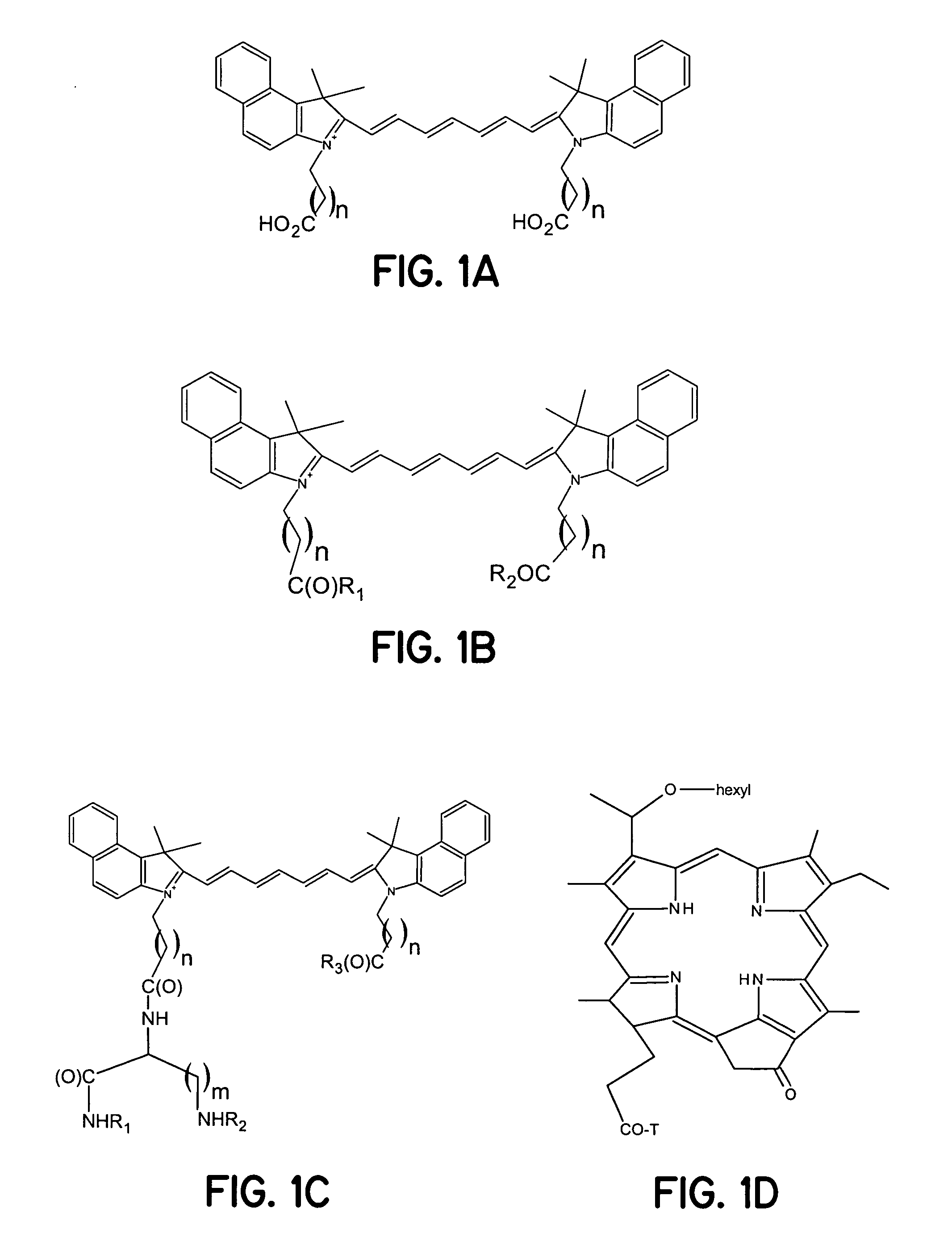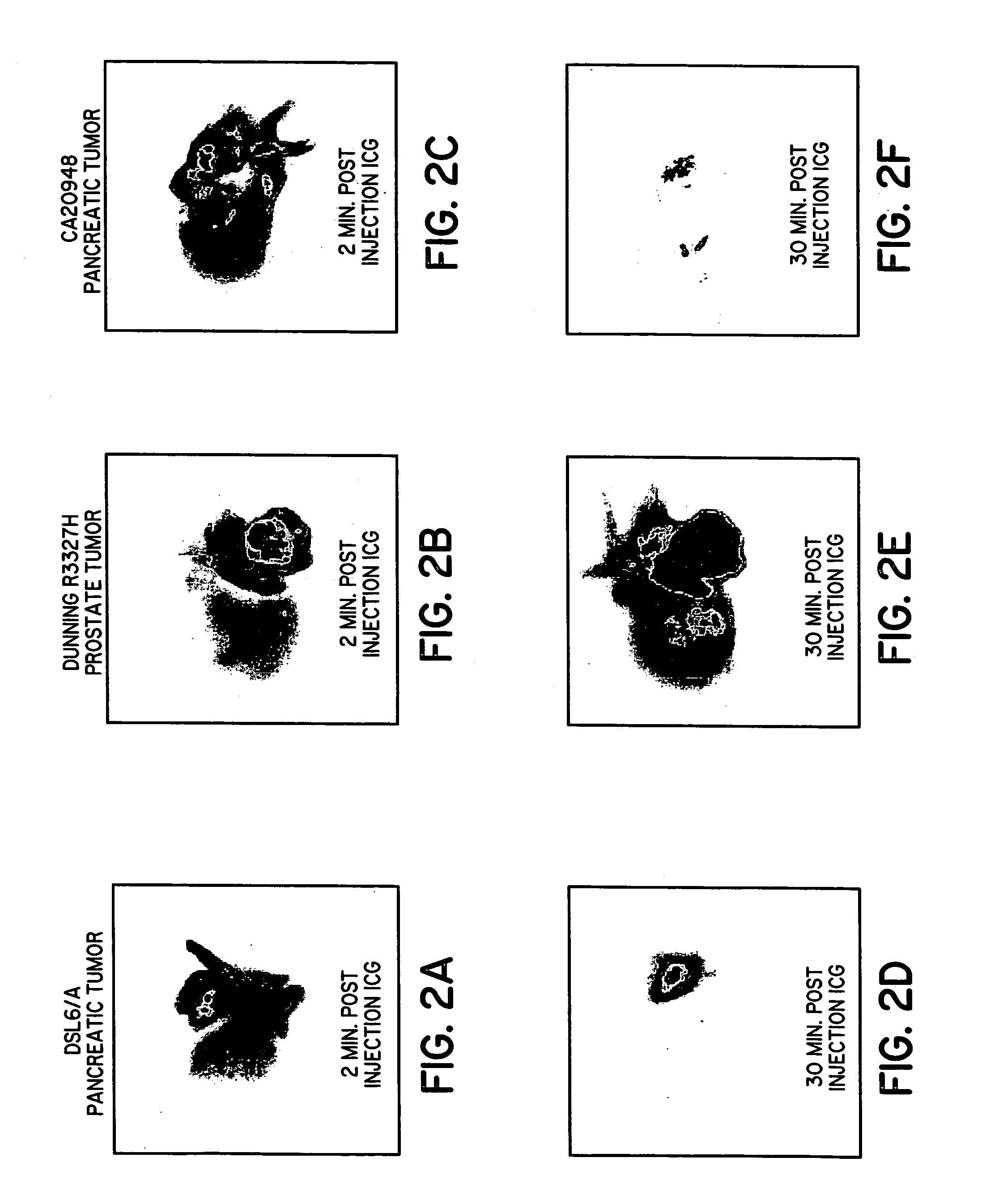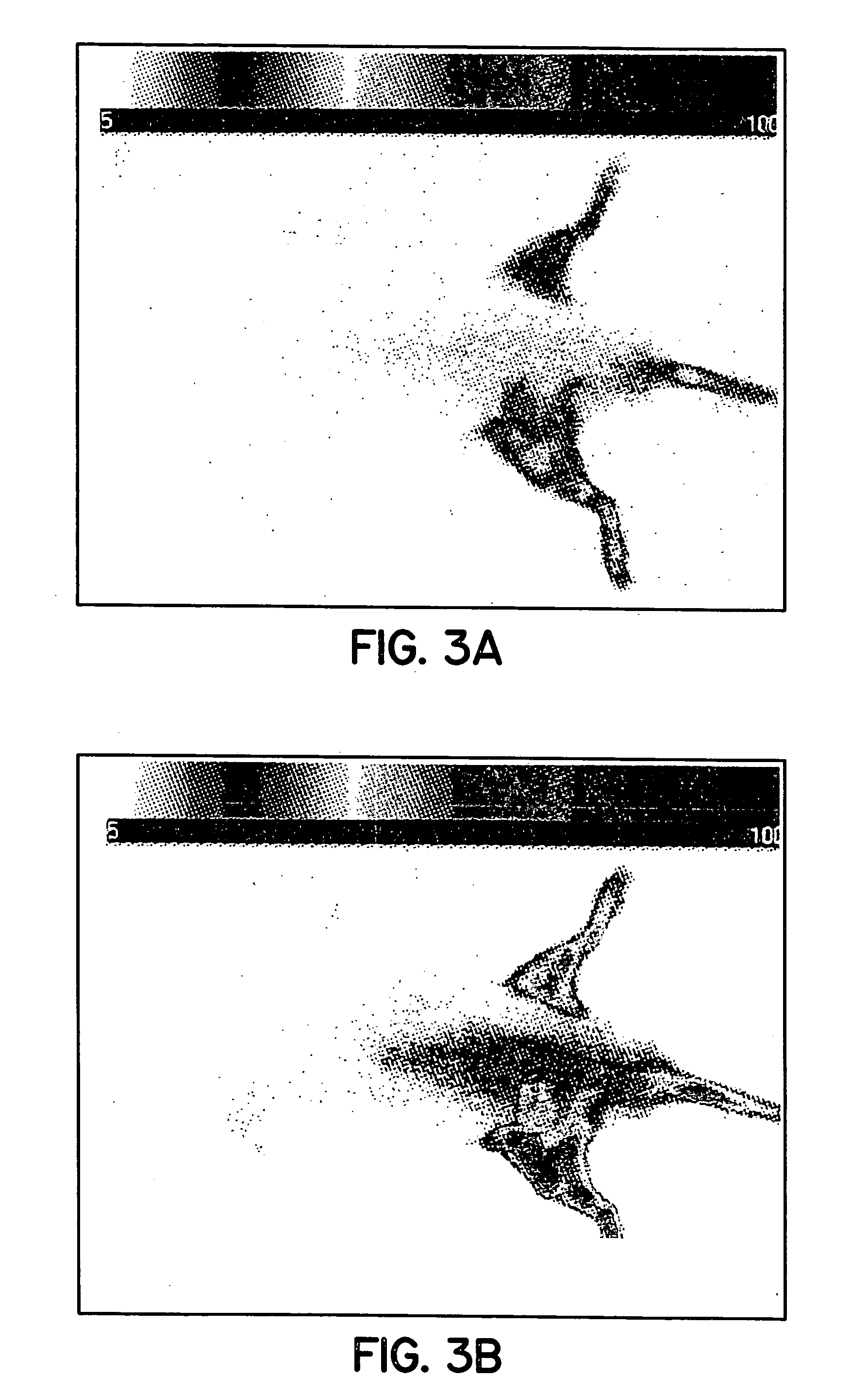Pathological tissue detection and treatment employing targeted optical agents
a technology of optical agents and tissue detection, applied in the direction of cardiovascular disorders, peptides, drug compositions, etc., can solve the problems of inability to combine the roles of tumor-seeking, diagnostic and therapeutic functions, and many benefits of early medical intervention may have been already compromised, and achieve the effects of reducing the risk of cancer
- Summary
- Abstract
- Description
- Claims
- Application Information
AI Technical Summary
Benefits of technology
Problems solved by technology
Method used
Image
Examples
example 1
Synthesis of Indocyaninebispropanoic Acid Dye (FIG. 1A, n=1)
[0039]A mixture of 1,1,2-trimethyl-[1H]-benz[e]indole (9.1 g, 43.58 mmoles) and 3-bromopropanoic acid (10.0 g, 65.37 mmoles) in 1,2-dichlorobenzene (40 ml) was heated at 110° C. for 12 hours. The solution was cooled to ambient temperature. The red residue obtained was filtered and washed with acetonitrile:diethyl ether (1:1v / v) mixture. The solid obtained was dried at ambient temperature under vacuum to give 10 g (64%) of light brown powder.
[0040]A portion of this solid (6.0 g; 16.56 mmoles), glutaconic aldehyde dianilide hydrochloride (Lancaster Synthesis, Windham, N.H.) (2.36 g, 8.28 mmoles), and sodium acetate trihydrate (2.93 g, 21.53 mmoles) in ethanol (150 ml) were refluxed for 90 minutes. After evaporating the solvent, 40 ml of a 2 N aqueous HCl was added to the residue. The mixture was centrifuged and the supernatant was decanted. This procedure was repeated until the supernatant became nearly colorless. About 5 ml ...
example 2
Synthesis of Indocyaninebishexanoic Acid Dye (FIG. 1A, n=4)
[0041]A mixture of 1,1,2-trimethyl-[1H]-benz[e]indole (20 g, 95.6 mmoles) and 6-bromohexanoic acid (28.1 g, 144.1 mmoles) in 1,2-dichlorobenzene (250 ml) was heated at 110 C for 12 hours. The green solution was cooled to ambient temperature and the brown solid precipitate that formed was collected by filtration. After washing the solid with 1,2-dichlorobenzene and diethyl ether, the brown powder obtained (24 g, 64%) was dried under vacuum at ambient temperature. A portion of this solid (4.0 g; 9.8 mmoles) glutacoaldehyde dianil monohydrochloride (1.4 g, 5 mmoles) and sodium acetate trihydrate (1.8 g, 12.9 mmoles) in ethanol (80 ml) were refluxed for 1 hour. After evaporating the solvent, 20 ml of 2 N aqueous HCl was added to the residue. The mixture was centrifuged and the supernatant was decanted. This procedure was repeated until the supernatant became nearly colorless. About 5 ml of a water:acetonitrile (3:2v / v) mixture w...
example 3
Synthesis of Peptides
[0042]Peptides of this invention were prepared by similar procedures with slight modifications in some cases.
[0043]Octreotate, an octapeptide, has the amino acid sequence D-Phe-Cys′-Tyr-D-Trp-Lys-Thr-Cys′-Thr (SEQ ID NO:1), wherein Cys′ indicates the presence of an intramolecular disulfide bond between two cysteine amino acids. Octreotate was prepared by an automated fluorenylmethoxycarbonyl (Fmoc) solid phase peptide synthesis using a commercial peptide synthesizer from Applied Biosystems (Model 432A SYNERGY Peptide Synthesizer). The first peptide cartridge contained Wang resin pre-loaded with Fmoc-Thr on a 25-μmole scale. Subsequent cartridges contained Fmoc-protected amino acids with side chain protecting groups for the following amino acids: Cys(Acm), Thr(t-Bu), Lys(Boc), Trp(Boc) and Tyr(t-Bu). The amino acid cartridges were placed on the peptide synthesizer and the product was synthesized from the C- to the N-terminal position according to standard procedu...
PUM
| Property | Measurement | Unit |
|---|---|---|
| of wavelength | aaaaa | aaaaa |
| wavelengths | aaaaa | aaaaa |
| wavelengths | aaaaa | aaaaa |
Abstract
Description
Claims
Application Information
 Login to View More
Login to View More - R&D
- Intellectual Property
- Life Sciences
- Materials
- Tech Scout
- Unparalleled Data Quality
- Higher Quality Content
- 60% Fewer Hallucinations
Browse by: Latest US Patents, China's latest patents, Technical Efficacy Thesaurus, Application Domain, Technology Topic, Popular Technical Reports.
© 2025 PatSnap. All rights reserved.Legal|Privacy policy|Modern Slavery Act Transparency Statement|Sitemap|About US| Contact US: help@patsnap.com



